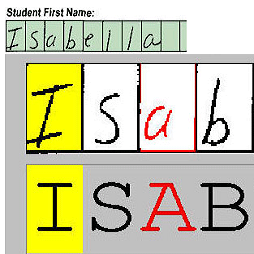Some historical and more recent printed documents have been scanned or stored at very low resolutions, such as 60 dpi. Though such scans are relatively easy for humans to read, they still present significant challenges for optical character recognition (OCR) systems. The current state-of-the art is to use super-resolution to reconstruct an approximation of the original high-resolution image and to feed this into a standard OCR system. Our novel end-to-end method bypasses the super-resolution step and produces better OCR results. This approach is inspired from our understanding of the human visual system, and builds on established neural networks for performing OCR. Our experiments have shown that it is possible to perform OCR on 60 dpi scanned images of English text, which is a significantly lower resolution than the state-of-the-art, and we achieved a mean character level accuracy (CLA) of 99.7% and word level accuracy (WLA) of 98.9% across a set of about 1000 pages of 60 dpi text in a wide range of fonts. For 75 dpi images, the mean CLA was 99.9% and the mean WLA was 99.4% on the same sample of texts. We make our code and data (including a set of low-resolution images with their ground truths) publicly available as a benchmark for future work in this field.
翻译:60 dpi 等一些历史和较近期印刷文件已被扫描或以非常低的分辨率存储,例如60 dpi 。虽然这种扫描对于人类来说相对容易阅读,但它们对光学字符识别系统仍构成重大挑战。目前最先进的技术是使用超级分辨率来重建原始高分辨率图像的近似,并将其输入标准的 OCR 系统。我们的新式端对端方法绕过超级分辨率步骤,产生更好的OCR结果。这个方法来自我们对人类视觉系统的理解,并且建立在已有的神经网络上进行OCR。我们的实验表明,可以对60 dpi 扫描的英文文本进行OCR,而这种图像的分辨率远低于最新版本,而且我们达到了99.7%的平均性能水平和字级准确度(WLA),在一套大约1000页的60 dpi 文本的宽广字体中达到了98.9%。对于75 dpi 的图像,其平均值是99.9%,而中WLA的平均值则是用60 dpi扫描的60 dpi 图像。我们用了一个相同的地面的样本,我们用这个地面标定了一个相同的图像。



